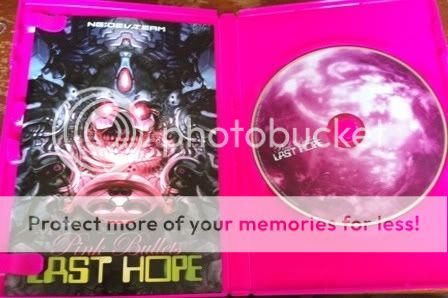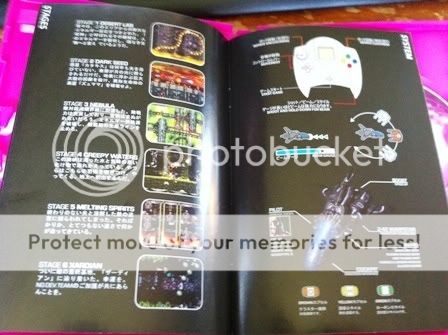|
Although homebrew console games are a phenomenon that have been with gaming for decades, the relatively recent popularity of emulators and the web itself have created a rich environment for an ongoing renaissance in self-made games. Almost every classic game system has enjoyed an assortment of wonderful homebrew games over the past decade, including those that have seen official releases in formats original to the systems that they are created for. Since this blog attempts to chronicle games released both at a system's launch and a system's end (and beyond), these games are a natural fit.
Last Hope is an especially interesting candidate, as it is not only a "last" game for one particular console, but for three. Developed in 2006 by NG:DEV.TEAM for the Neo Geo, Neo Geo CD, and Dreamcast, Last Hope is a horizontal-scrolling shooter that borrows obvious inspiration from games like IREM's R-Type and Aicom's Pulstar. More polished and better produced then a majority of homebrew games, NG.DEV.TEAM's game was generally well-regarded by consumers and reviewers alike. Furthermore, the most common complaints about the game (the difficulty, the tough-to-discern appearance of various objects, etc.) were addressed in an updated 2007 release for the Dreamcast entitled Last Hope: Pink Bulllets.
One of the most impressive feats of this release is that NG:DEV.TEAM made an effort to mimic the standard packaging for each of the ports of the game. This adds to the overall sense of high production quality found in the game itself, and rounds out the full package nicely. Because the AES carts were prohibitively expensive to produce, only 60 were made and sold, for around $700 each. Because of the rarity, prices for the game have gone upwards of $1000+ in the time since. The Neo Geo and Dreamcast versions were available for closer to $30-$50 each, depending on whether the standard or limited edition (with a soundtrack) was purchased. All versions of the game were region free, so they could be played on any system.
Here you can see what each version looked like (sorry for the watermarks, but I don't have my own copies of these.)
 The Neo Geo AES cart, box, and manual  The Neo Geo CD case, disc, and manual  The Dreamcast case, art, and manual
The version I own is the aforementioned Pink Bullets update for the Dreamcast. For this release, NG:DEV.TEAM opted to go with a pink DVD-style case instead of a standard jewelcase. I can't say I am a big fan of the redesigned packaging since I like my Dreamcast games all to look the same on the shelf, but the general quality of the paper, printing, etc. is still high.
 The inside of the Pink Bullets edition of the game
As an "end game," there are several things worth noting about Last Hope:
The old-school look and feel. Since the game was designed for the Neo Geo and then ported to the Dreamcast, the game retains the style and appearance of other shooters from the early 90s. What that means is that the Neo Geo ports are some of the better looking shmups available for the system while the Dreamcast port is one of the least visually impressive shooters available for that console. The game also plays like those other "tactical" shmups that inspired it: it is a tough game that will leave even veteran gamers muttering obscenities at the screen.
The soundtrack. One aspect of the game that received almost universal acclaim was the soundtrack by composer Rafael Dyll. Full of creatively employed, sweeping synthesizers and strings, the game is a joy to listen to. Since the Dreamcast version was published on a CD-ROM instead of a GD-ROM, it can be listened to on a CD player. Dyll has since gone on to produce the excellent soundtracks for both Soldner-X games.
 Dreamcast features are listed on the back of the box
The extra touches for the Dreamcast. Since I only have the Pink Bullets edition, I can't comment on how well the game takes advantage of the tech available on the Neo Geo systems. What I can comment on is the ways in which the game includes features that highlight the strength of the Dreamcast. For one, the game includes VMU support as some graphics are displayed on the screen and scores can be saved. It also supports the use of a VGA box, something that wasn't true for all DC games. Perhaps most importantly, the game provides support for a Dreamcast arcade stick should the player wish to use one. I found that the standard DC controller worked well as you could use the L and R triggers to rotate the pod on the outside of the ship clockwise or counterclockwise, something that feels awkward on an arcade stick but natural on the DC controller.
 The Dreamcast manual
Last Hope is not ever going to be mistaken for one of the greatest shooters ever, but it is one of the best post-system life-cycle shooters I have come across thus far. It seems that NG:DEV.TEAM is dedicated to producing high quality work and the success behind a release like this will help keep the Neo Geo and Dreamcast viable as platforms to receive new games. And while it is technically a homebrew game, it is presented very much like a licensed title. For me, those little touches make a big difference.
The team that created Last Hope have gone on to produce other post-life cycle games (they recently released another AES cart). Here's hoping that we see another Dreamcast port!
|
|
|
|

